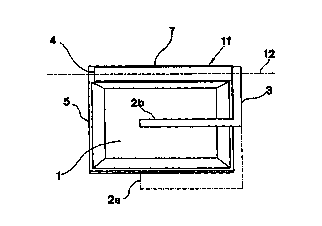Some of the information on this Web page has been provided by external sources. The Government of Canada is not responsible for the accuracy, reliability or currency of the information supplied by external sources. Users wishing to rely upon this information should consult directly with the source of the information. Content provided by external sources is not subject to official languages, privacy and accessibility requirements.
Any discrepancies in the text and image of the Claims and Abstract are due to differing posting times. Text of the Claims and Abstract are posted:
| (12) Patent Application: | (11) CA 2320069 |
|---|---|
| (54) English Title: | DEVICE FOR A CONTAINER WITH A HANDLE |
| (54) French Title: | DISPOSITIF DESTINE A UN CONTENEUR DOTE D'UNE POIGNEE |
| Status: | Deemed Abandoned and Beyond the Period of Reinstatement - Pending Response to Notice of Disregarded Communication |
| (51) International Patent Classification (IPC): |
|
|---|---|
| (72) Inventors : |
|
| (73) Owners : |
|
| (71) Applicants : |
|
| (74) Agent: | ADE & COMPANY |
| (74) Associate agent: | |
| (45) Issued: | |
| (86) PCT Filing Date: | 1999-02-12 |
| (87) Open to Public Inspection: | 1999-09-02 |
| Availability of licence: | N/A |
| Dedicated to the Public: | N/A |
| (25) Language of filing: | English |
| Patent Cooperation Treaty (PCT): | Yes |
|---|---|
| (86) PCT Filing Number: | PCT/SE1999/000188 |
| (87) International Publication Number: | SE1999000188 |
| (85) National Entry: | 2000-08-14 |
| (30) Application Priority Data: | ||||||
|---|---|---|---|---|---|---|
|
The invention is related to a device in a container of the type basket for
merchandise or customer's basket for providing a handle or grip, which is
properly designed from an ergonomic point of view. The handle or grip design,
which is common today, requires the lifting hand to have to be rotated into an
unnatural angle. If the lifting hand would assume the natural angle at rest, a
long side of the basket will be turned forwardly in the walking direction. The
invention solves this by orientating the grip or handle (2) with its
longitudinal direction substantially parallel to a long side of the basket
whereas at the same time the attachment (3, 4) of the handle to the basket
along one long side provides for a maximum amount of availability for handling
merchandise present in the basket.
L'invention concerne un dispositif destiné à un conteneur de type panier de marchandises ou panier de client, et conçu pour procurer une poignée ou une anse de conception ergonomique. Actuellement, la poignée ou l'anse exigent que la main qui porte le panier doit être tournée dans un angle non naturel. Pour que la main qui porte le panier, ait un angle naturel au repos, il faut mettre un grand côté du panier de face dans le sens de la marche. Pour résoudre ce problème, la poignée ou l'anse (2) est orientée de telle façon que sa direction longitudinale soit sensiblement parallèle au grand côté du panier. De plus, la fixation (3, 4) qui relie l'anse au panier et qui est placée sur toute la longueur d'un grand côté du panier, offre une accessibilité maximale pour la manipulation des marchandises contenues dans le panier.
Note: Claims are shown in the official language in which they were submitted.
Note: Descriptions are shown in the official language in which they were submitted.

2024-08-01:As part of the Next Generation Patents (NGP) transition, the Canadian Patents Database (CPD) now contains a more detailed Event History, which replicates the Event Log of our new back-office solution.
Please note that "Inactive:" events refers to events no longer in use in our new back-office solution.
For a clearer understanding of the status of the application/patent presented on this page, the site Disclaimer , as well as the definitions for Patent , Event History , Maintenance Fee and Payment History should be consulted.
| Description | Date |
|---|---|
| Application Not Reinstated by Deadline | 2003-02-12 |
| Time Limit for Reversal Expired | 2003-02-12 |
| Deemed Abandoned - Failure to Respond to Maintenance Fee Notice | 2002-02-12 |
| Inactive: Cover page published | 2000-11-14 |
| Inactive: First IPC assigned | 2000-11-08 |
| Inactive: Notice - National entry - No RFE | 2000-10-24 |
| Application Received - PCT | 2000-10-20 |
| Application Published (Open to Public Inspection) | 1999-09-02 |
| Abandonment Date | Reason | Reinstatement Date |
|---|---|---|
| 2002-02-12 |
The last payment was received on 2001-01-22
Note : If the full payment has not been received on or before the date indicated, a further fee may be required which may be one of the following
Patent fees are adjusted on the 1st of January every year. The amounts above are the current amounts if received by December 31 of the current year.
Please refer to the CIPO
Patent Fees
web page to see all current fee amounts.
| Fee Type | Anniversary Year | Due Date | Paid Date |
|---|---|---|---|
| Basic national fee - small | 2000-08-14 | ||
| MF (application, 2nd anniv.) - small | 02 | 2001-02-12 | 2001-01-22 |
Note: Records showing the ownership history in alphabetical order.
| Current Owners on Record |
|---|
| LINA LINDBERG |
| Past Owners on Record |
|---|
| None |